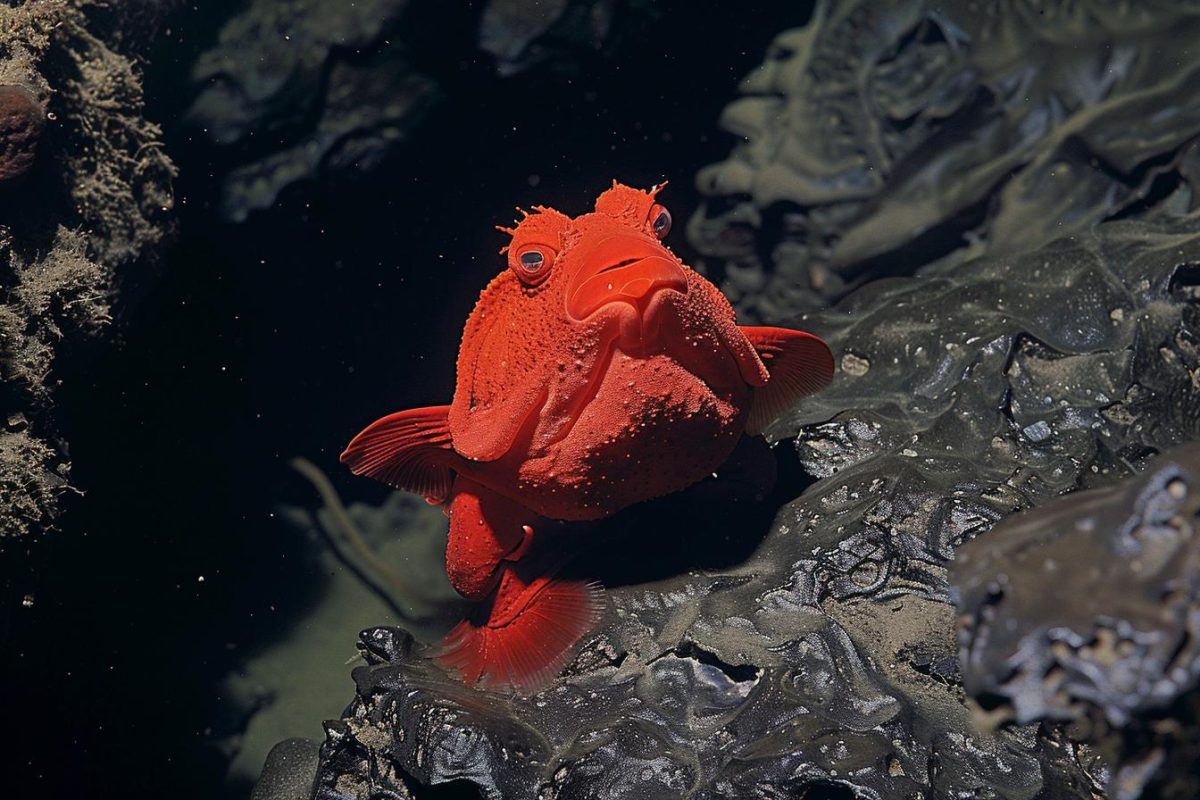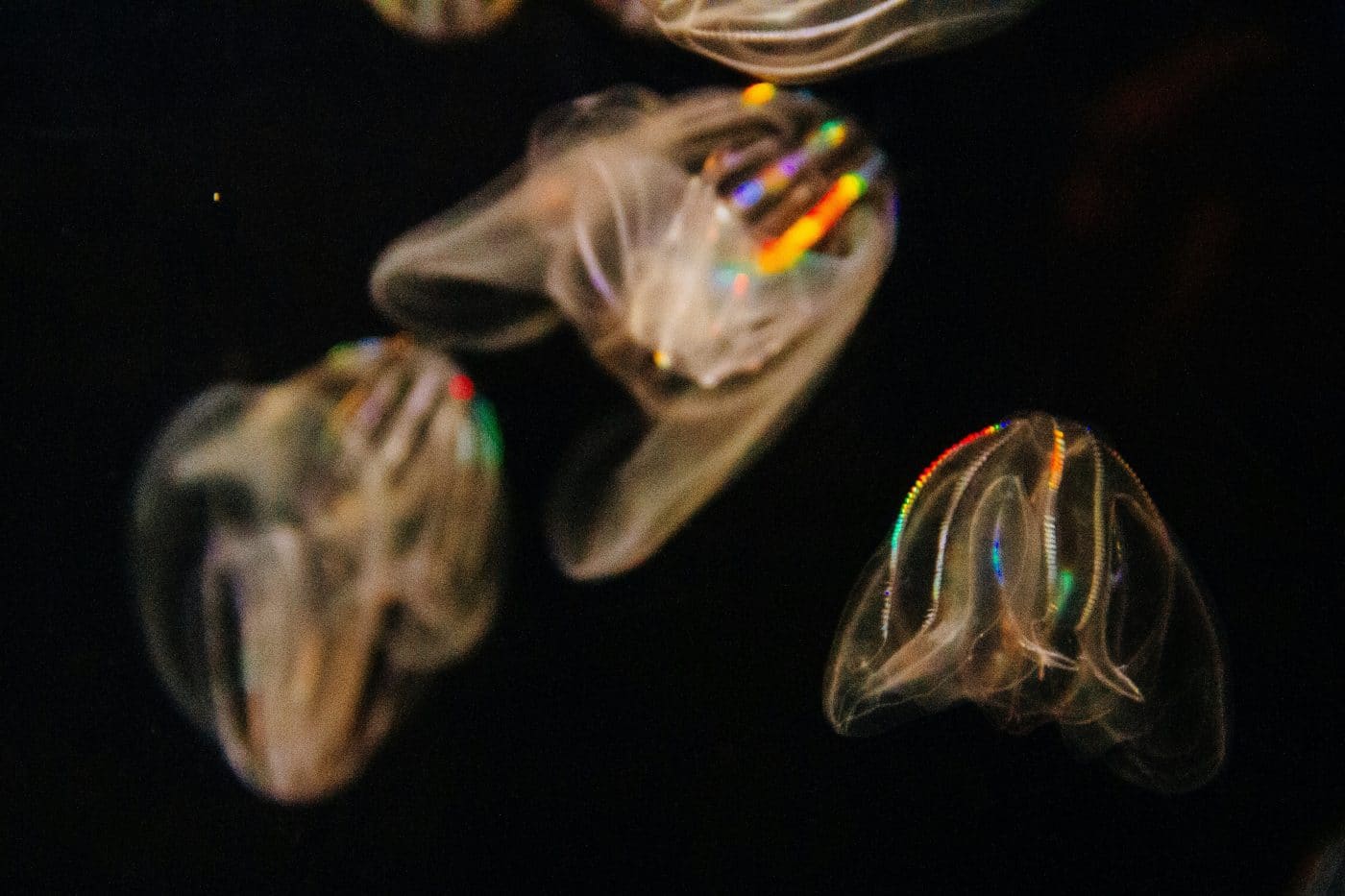
Check out our latest products
MidJourney
The deep sea is a place where logic takes a vacation. It’s pitch black, freezing, and under crushing pressure—yet life not only exists, it flourishes. Scientists have barely scratched the surface of Earth’s oceans, and each year uncovers bizarre new creatures that seem born of a fever dream. Some glow, some resemble shoelaces with eyes, and others make evolution look like it was laughing. As marine biologists try to decode them, these mysterious critters keep drifting by—armed with extra teeth and unapologetically weird vibes.
Comb Jelly (Ctenophore)

Shutterstock
Looking like a living lava lamp, the Comb Jelly floats through the ocean using rows of tiny, shimmering cilia that refract light like a rainbow rave. Unlike jellyfish, they don’t sting—yet they’re still formidable predators. Scientists are fascinated by how they move, hunt, and reproduce, and the debate continues over where they even belong on the evolutionary tree. Some argue they’re more ancient than sponges, which would completely upend our understanding of multicellular life. All that, and they still look like the ocean’s version of a screensaver.
Pelican Eel

MidJourney
No relation to the Gulper Eel but equally confusing, the Pelican Eel has an enormous pouch-like lower jaw that can unhinge to swallow large prey whole. It also has a glowing organ on the end of its tail to attract dinner, because nothing says “classy predator” like a built-in disco lure. Scientists don’t know much about its feeding behavior, reproductive cycle, or how often it gets asked if it’s part balloon. It’s a mystery wrapped in a jaw wrapped in pure weirdness.
Bigfin Squid

MidJourney
If you’ve ever wanted to see a deep-sea marionette, the Bigfin Squid is your unsettling wish come true. These squids have long, elbowed arms that can extend many times the length of their body, trailing eerily as they hover in the deep. Their movements are slow and ghostly, and their exact purpose remains unknown. Very few have ever been observed, and their biology is mostly hypothetical. One theory: they’re just here to haunt our dreams.
Deep-Sea Lizardfish

MidJourney
Part fish, part lizard, part horror story, the Deep-Sea Lizardfish is a sharp-toothed predator that lies in wait on the ocean floor. It has needle-like teeth and a perpetually grumpy expression, like it’s tired of explaining itself to marine biologists. Scientists are still unsure how it hunts so effectively in pitch darkness or how it processes prey with such a minimalist digestive system. Its entire vibe screams “I was born in the shadows, and I like it that way.”
Coffinfish

MidJourney
Despite its morbid name, the Coffinfish is basically a squishy balloon with a grumpy face. It inflates its body when threatened and hangs out near the seafloor, where it barely moves unless food is nearby. Scientists are still studying its defensive mechanisms and the purpose of its strange, retractable lure. Its biology is so slow-paced, it makes sloths look like sprinters. Coffinfish: because sometimes the ocean just wants to make a stress ball come to life.
Sarcastic Fringehead

MidJourney
Don’t let the name fool you—this fish is more dramatic than sarcastic. When threatened, the Sarcastic Fringehead opens its mouth to reveal a comically wide and colorful display, flaring out like a living Muppet in battle mode. Found in deeper coastal waters, this creature is aggressive and territorial, and scientists are still studying its behavior and feeding strategies. Its jaw-dueling contests with other fringeheads are both hilarious and terrifying. Nature really said, “Give that fish emotional issues and a flair for theatrics.”
Glass Sponge

MidJourney
This bizarre creature forms intricate, delicate skeletons made of silica—yes, glass—and lives deep on the ocean floor. Despite their fragility, Glass Sponges can live for thousands of years and serve as habitats for other sea creatures. Scientists don’t fully understand how they grow, how they filter feed so efficiently, or how their seemingly brittle structure survives the deep sea’s pressure. They’re living chandeliers that defy both time and physics.
Telescope Octopus

MidJourney
This transparent octopus is one of the most elusive creatures in the ocean. It has tubular, rotating eyes—an extremely rare trait in the animal kingdom—and a nearly invisible body. It drifts in the midwater zones, floating like a jelly-filled balloon of mystery. Its camouflage is so effective that studying it is nearly impossible without high-tech submersibles. Scientists are still trying to figure out how it navigates, hunts, and mates without revealing itself to the entire food chain.
Deep-Sea Anglerfish

MidJourney
Famous for their bioluminescent head-lure and nightmare-inducing appearance, deep-sea Anglerfish are icons of the abyss. But what’s truly mind-bending is their reproduction: tiny male anglerfish fuse to the females’ bodies, becoming permanent sperm-dispensers. This bizarre parasitic mating behavior still puzzles scientists, as does the fish’s metabolism and light-producing ability. Honestly, the deep-sea anglerfish is basically nature’s version of “weird flex, but okay.”
Ping-Pong Tree Sponge

MidJourney
With a name this cute, you’d expect something fluffy and harmless. Wrong. This sponge lives in the deep ocean and uses microscopic hooks to trap and digest tiny animals—yes, a carnivorous sponge. Scientists are still unsure why or how this evolved, but it challenges everything we thought we knew about sponges being chill ocean furniture. This little puffball is out here slaying.
Atolla Jellyfish

MidJourney
Nicknamed the “alarm jelly,” the Atolla Jellyfish uses bioluminescence in a pulsing, spiral display to attract predators of its predators when it’s attacked. It’s basically a glowing distress beacon with tentacles. But scientists still can’t explain how it coordinates its flashy displays or how widespread this defense tactic is. All we know is it’s like a living rave with self-defense instincts.
Zombie Sea Star

MidJourney
After mysterious sea star wasting diseases wiped out millions of starfish, some populations began regrowing in strange ways—like with extra limbs or partial regeneration. Scientists are still studying how these “zombie” sea stars are returning, and whether their mutations are signs of adaptation or something more ominous. Their eerie regrowth and behavior have left researchers both hopeful and creeped out. The ocean’s version of “back from the dead” just got literal.
Chimaera (Ghost Shark)

MidJourney
These deep-sea cousins of sharks and rays are rarely seen, earning them the nickname “ghost sharks.” With wing-like pectoral fins and long, thread-like tails, Chimaeras drift along the seabed like underwater phantoms. Scientists are still learning about their reproduction, sensory systems, and evolutionary background. Their eyes glow, their faces are oddly humanoid, and their existence raises more questions than answers. If the ocean had haunted mansions, Chimaeras would be the butlers.
Psychrolutes phrictus (Blob Sculpin)

MidJourney
Often mistaken for the blobfish’s sad cousin, the Blob Sculpin looks like someone sculpted a fish out of mashed potatoes and left it in the sun. This deep-sea dweller has a gelatinous body designed to withstand the crushing pressure of the ocean depths, where bones are basically optional. Scientists are still unclear on many aspects of its lifestyle, including how it finds food and why it insists on looking perpetually disappointed. It also guards its eggs—an unusual trait for a deep-sea fish, making it both weird and oddly nurturing. Basically, it’s the grumpy parent of the abyss.
Sea Toad (Chaunacidae)

MidJourney
This deep-sea frogfish waddles more than it swims, using modified fins to walk along the seafloor like it’s on a never-ending grocery run. Its strange, bloated body and odd locomotion puzzle scientists who wonder how such an inefficient mover survives in such a harsh environment. Some species even have a bioluminescent lure on their snouts, which only raises more questions. What does it hunt? Why does it look like it’s late for a meeting? Science is still catching up.
We Sea What You Did There, Nature

MidJourney
And there you have it—fifteen of the ocean’s most mind-bending, logic-defying, eyebrow-raising creatures that continue to leave scientists blinking at their research notes. From transparent heads to bone-melting worms, these deep-sea residents prove that evolution sometimes throws the rulebook out the porthole and just starts improvising. One thing’s for sure: until we explore every trench and abyss, the sea will keep its secrets—and probably a few more creepy surprises with teeth. So the next time you dip a toe in the water, just remember… something down there is probably watching. And it might be smiling. With too many teeth.







![[5G & 2.4G] 2K Indoor Security Camera for Home Security, AI Voice Change for 2-Way Talk, Motion Detection, Night Vision, 24/7 SD Recording/Cloud Storage, WiFi Home Camera, Pet Cam with Phone App](https://i3.wp.com/m.media-amazon.com/images/I/61I2U+sTT3L._AC_SL1500_.jpg?w=300&resize=300,300&ssl=1)






